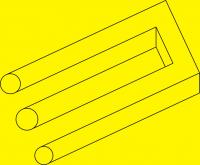- Configuring LinuxCNC
- Configuration Tools
- StepConf Wizard
- Configuring a L297 Board Reprap Stepper v1.2)
Configuring a L297 Board Reprap Stepper v1.2)
- gatonero
- Offline
- New Member
-

- Posts: 7
- Thank you received: 0
after 10 days trying to get my Mini-CNC mill running with EMC2, reading a lot of tutorials and forum threads I'm still not able to get my machine running as expected.
This is what the machine is doing:
X axis: both jog directions move towards the minus direction
Y axis just one jog direction moves towards minus direction, the other doesn't move
Z axis: runs perfectly
I'm running Ubuntu 10.04 "Lucid Lynx" LTS with EMC2/AXIS version 2.4.5.
I'm using a RepRap Stepper Motor Driver 1.2 which is wired as you can see here www.flickr.com/photos/mantao05/437399371...es/o/in/photostream/ . It's an ordinary L297 / L298 board with STEP, DIR, ENABLE, MIN-LIMIT and MAX-LIMIT pins. For each axis one board is necessary. Where you can see the Arduino board in the drawing, I'm connecting a parallel printer cable, which is connected to my PC, without the ground contact. For further informations please have a look for Wiring . All axis are wired and configured identically.
This is my .hal file which I got from stepconf: (see attachment)
Why is there no yenable and zenable?
Any help is highly appreciated.
Please Log in or Create an account to join the conversation.
- Rick G
-

- Offline
- Junior Member
-

- Posts: 27
- Thank you received: 155
It has been my experience that if an axis moves the same direction no matter what direction you jog it then the direction signal is not changing. You could try connecting a meter to the direction pin and see if it changes when you change direction. It seems that you may need to change some of the pin assignments.
Rick G
Please Log in or Create an account to join the conversation.
- Rick G
-

- Offline
- Junior Member
-

- Posts: 27
- Thank you received: 155
Please Log in or Create an account to join the conversation.
- step4linux
- Offline
- Premium Member
-

- Posts: 94
- Thank you received: 5
I'm using a RepRap Stepper Motor Driver 1.2 which is wired as you can see here www.flickr.com/photos/mantao05/437399371...es/o/in/photostream/ . It's an ordinary L297 / L298 board with STEP, DIR, ENABLE, MIN-LIMIT and MAX-LIMIT pins. For each axis one board is necessary. Where you can see the Arduino board in the drawing, I'm connecting a parallel printer cable, which is connected to my PC, without the ground contact. For further informations please have a look for Wiring . All axis are wired and configured identically.
Maybe I missed something, but I have not seen how you wire the parallel printer cable to the whole thing.
why without ground contact ?
There are yenable and zenable signals in the hal as well as xenable.
But due to limited number of pins of a parallel port, stepconf uses only one enable for all axis.
You can connect this signal parallel to all your axes.
If you want individual enables, I assume you have to edit hal, excluding stepconf. I don`t see any reason for this in a typical machine.
Gerd
Please Log in or Create an account to join the conversation.
- gatonero
- Offline
- New Member
-

- Posts: 7
- Thank you received: 0
Here the description how I connected the stepper driver pins to the parallel cable. First I cut off one end of the parallel cable and connected the soldered the wires to a stripped perfboard. Via a pin connector I attached the stepper drivers. To reduce EMF i wrapped the whole thing with aluminum, of course isolated it before.
These are my connection settings:
Output Pin Function Invert
1 Unused
2 XDIR
3 XSTEP
4 YDIR
5 YSTEP
6 ZDIR
7 ZSTEP
8 Unused
9 Unused
14 AMP-ENABLE
16 AMP-ENABLE
17 AMP-ENABLE
Input Pin Function Invert
10 XMAX yes
11 XMIN + Home yes
12 YMAX yes
13 YMIN + Home yes
15 ZMAX + Home yesgatonero
Please Log in or Create an account to join the conversation.
- andypugh
-

- Offline
- Moderator
-

- Posts: 23543
- Thank you received: 5015
It is common (and preferable) for parport signals to be active-low, especially amp-enable as unconnected pins tend to get pulled high.
Please Log in or Create an account to join the conversation.
- gatonero
- Offline
- New Member
-

- Posts: 7
- Thank you received: 0
Most helpfully was the question
[quotewhy without ground contact ?][/quote]
So to make the adapter from the parallel port to the L297 / L298 boards I made something more reliable and conntected the GNDs. to one parallel port GND.
I also connected the ENABLE signals parallel to the L297 / L298 ENABLE pins.
To use the oscilloscope wasn't really necessary for getting the machine running, a multimeter with continuity testing made the job.
Now I'm looking forward to get full control with EMC2 :-D
Thanks
Christoph
Please Log in or Create an account to join the conversation.
- Configuring LinuxCNC
- Configuration Tools
- StepConf Wizard
- Configuring a L297 Board Reprap Stepper v1.2)



